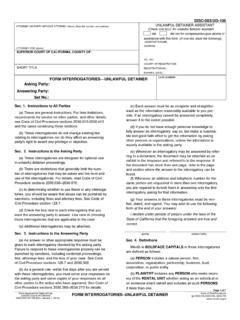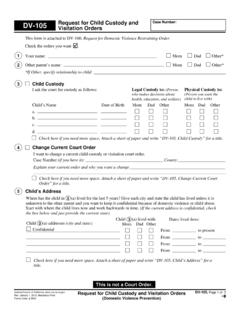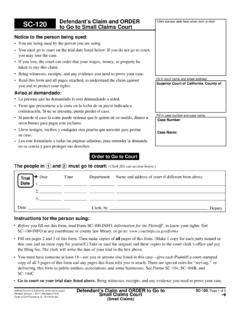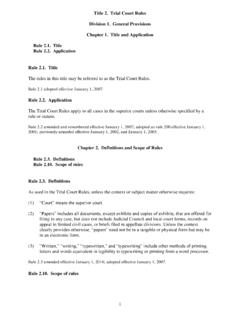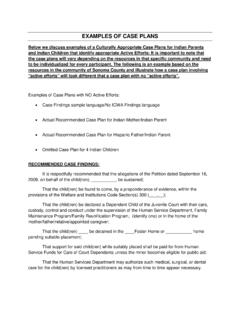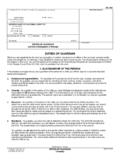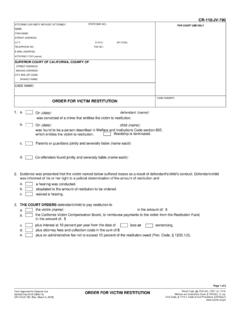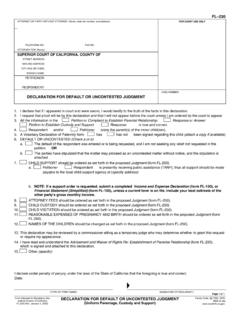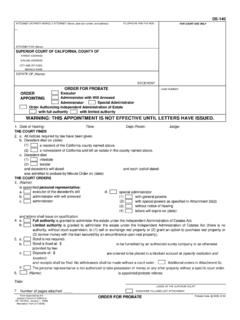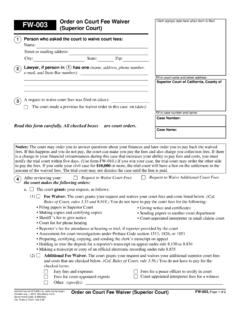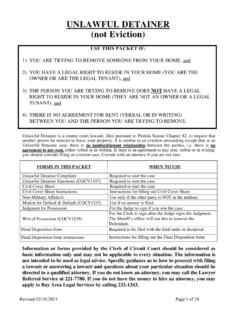Transcription of EVICTIONS - California
1 SUPERIOR COURT OF California COUNTY OF BUTTE Self-Help Assistance & Referral Program EVICTIONS ( unlawful DETAINERS) Code of Civil Procedure section 1161 et seq. 1 LANDLORD - HOW TO GET STATED Notices to Terminate A lawsuit to evict a tenant is called an unlawful detainer . The eviction process begins when the tenant is given a notice from the landlord to move out. If the tenant does not move out in time, the landlord can file a lawsuit. The one who is bringing the lawsuit is called the plaintiff. The one who is being sued is called the defendant. 3-DAY NOTICES A landlord may terminate a tenancy by giving a Three Day Notice to Pay Rent or Vacate Premises to the tenant(s), in the manner prescribed by Civil Procedure section 1162 provided the tenant(s) has failed to pay rent and the rent is late pursuant to the rental agreement.
2 A copy of a Three-Day Notice to Pay Rent or Vacate Premises is attached at the end of this section. 30-DAY NOTICES A landlord may terminate a month-to-month (not a fixed term lease unless the lease has expired and the tenant(s) will not move) tenancy by giving a Thirty (30) Day Notice to Quit to the tenant(s), in the manner prescribed by Civil Procedure section 1162. A copy of a Thirty (30) Notice to Quit is attached as the end of this section. WARNING: A bill requiring landlords to provide tenants with a sixty (60) day eviction notice passed the California Assembly Committee in June, 2002. Please check updates regarding Civil Code section 1946 prior to preparing a serving a Thirty (30) Day Notice. (For research regarding mobilehomes or trailer coaches see Civil Code section 798 et seq.)
3 (For research regarding commercial properties see Civil Code of Procedure ) 1. Procedure. Prepare an original, a copy for yourself, a client copy, a copy to be served and extra copies (to use in the case of substituted service or service by posting (see below)). 2. Service. Serve a copy the notice on the tenant and on any subtenant in actual occupation of the premises as described below. The landlord or the agent of the landlord may serve the notice. (Civil Code section 1946; Code of Civil Procedure section 1162) a. Personal Service: By personally delivering a copy to the tenant(s). b. Substituted Service: If the tenant(s) is absent from the place of residence or their business, the notice may be left with a person at the residence over the age of 18 at either place and sending a copy through the mail on the same date of substituted service, addressed to the tenant(s) at the place of residence.
4 C. Service by Posting: If the tenant cannot be found and you have been unable to properly serve by substituted service, then the notice can be served by affixing a copy in a conspicuous place on the property and sending a copy through the mail on the same date of the posting, to the tenant(s) at the place of residence. d. Complete a Proof of Service and keep the original of both the notice and Proof of Service. e. Calendar the date of termination so that any unlawful detainer proceedings may be promptly initiated if necessary. A copy of a Proof of Service that is appropriate to use for this procedure is attached at the end of this section. PLEASE NOTE: A landlord may terminate tenancy for other reasons, including failure of the tenant to perform a covenant of the lease.
5 Please refer to Civil Code of Procedure section 1161 et seq. SUPERIOR COURT OF California COUNTY OF BUTTE Self-Help Assistance & Referral Program EVICTIONS ( unlawful DETAINERS) Code of Civil Procedure section 1161 et seq. 2 LANDLORD SUMMONS & unlawful detainer COMPLAINT 1. Counting the Time to File the Summons and unlawful detainer Complaint. You may file the Summons and Complaint the day following the expiration of the notice(s) you have served on the tenant(s), provided that the notices have not been cured ( , tenants have not moved [30-Day Notice] or you have not received any payment towards rent [3-Day Notice to Pay Rent or Quit]). 2. Where to get the Summons and unlawful detainer Complaint Forms.
6 You can get the forms from the Self-Help Assistance & Referral Program site at 1931 Arlin Rhine Drive in Oroville, California or the courthouse where your case should be filed. Generally, your lawsuit should be filed within the court jurisdiction that is closest to the property in question. 3. What does it Cost to File an Answer? It costs $ to file your lawsuit. The fees will increase as of January 1, 2003. Please check with the clerk of the court to confirm the current filing fee. If your income is below a certain level, you can apply for a waiver of the filing fee. You can get a fee waiver application packet from the court clerk s office or from the SHARP center. 4. Who may file an unlawful detainer action?
7 Only the owner of the property (Plaintiff) or the owner s attorney may file an action to recover possession of the owner s property. 5. Who is named as Defendant in the action? The tenants in possession of the property that you have served the notices upon that have not cured the notices. WARNING: THE BUTTE COUNTY COURT S SELF-HELP ASSISTANCE & REFERRAL PROGRAM CENTER IS NOT REPRESENTING YOU, OR TELLING YOU WHICH CHOICE TO MAKE. IT HAS ONLY ASSISTED YOU IN REPRESENTING YOURSELF BY PROVIDING LIMITED INFORMATION ABOUT YOUR OPTIONS. NO ATTORNEY FROM SHARP WILL APPEAR IN COURT TO REPRESENT YOU AT TRIAL OR ANY OTHER HEARING. YOU ARE REPRESENTING YOURSELF.
8 THE SELF-HELP ASSISTANCE & REFERRAL PROGRAM STRONGLY RECOMMENDS THAT YOU SEEK THE ADVICE OF AN ATTORNEY IN THIS MATTER. HOW TO COMPLETE YOUR SUMMONS & COMPLAINT Complete the Summons and Complaint forms by typing (preferred) the information requested. If you cannot type the forms, make sure you print neatly using black ink. Summons Judicial Council Form No. 982 Under NOTICE TO DEFENDANT: List tenants exactly as you have named them in the notice(s) and add Does 1 through 10. Note: Does 1 through 10 will allow you to amend your Complaint prior to serving if you find you have misnamed, misspelled a name, or had to serve a notice on a tenant as a DOE because you did not know the tenant s name and later discovered the name.
9 Under YOU ARE BEING SUED BY PLAINTIFF: List the owner s name, which will be you as only the owner can bring the action for recovery of the real property. Under The name and address of the court is: Type or Print the name of the court and the court s address where you are filing your action. Example: Superior Court of California , County of Butte No. One Court Street Oroville, CA 95965 Under The name, address, and telephone number of plaintiff s attorney or plaintiff without an attorney, is : Your name Your Telephone Number Your Street Address Your Town, State In Pro Per (this indicates that you are representing yourself) Under the unlawful detainer assistant check the box for did not , unless you did pay a registered unlawful detainer assistant to assist you.
10 If you did, the unlawful detainer assistant will be completing all of the documents. A copy of the Summons is attached at the end of this section. Complaint- unlawful detainer (Judicial Council Form (90) Complete the Complaint form by typing (preferred) the information requested. If you cannot type the forms, make sure you print neatly using black ink. Completing the Caption The top part of the form is called the caption and it looks like this: a. In the box put your name, address, and telephone number, just like the example above. Where it says attorney for put In Pro Per . This means you represent yourself. b. In the next box down, put the name and address of the court where you are filing your action.)
